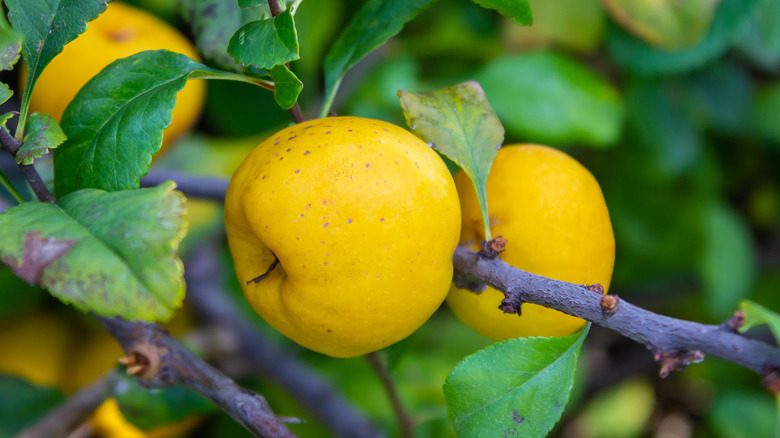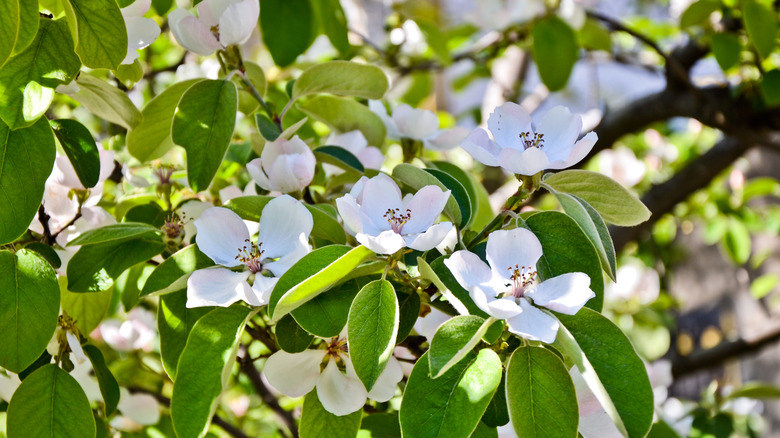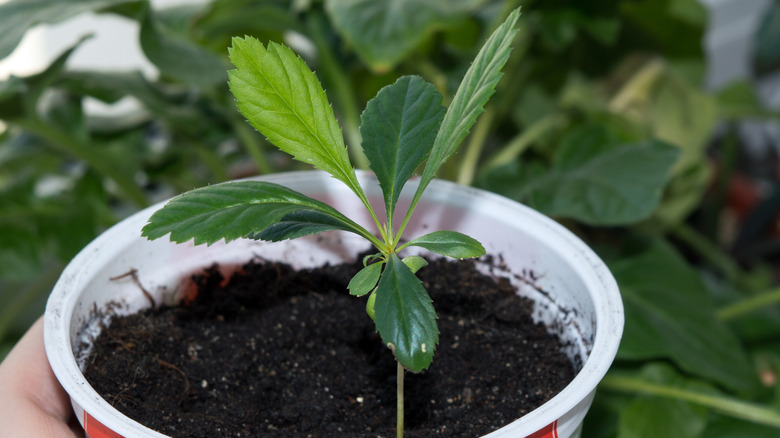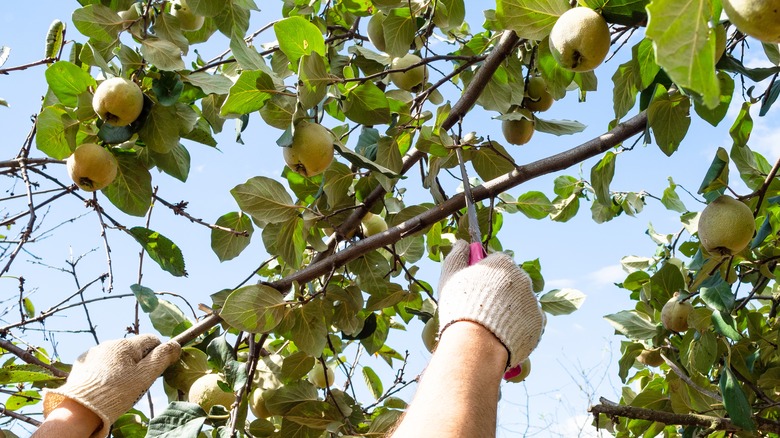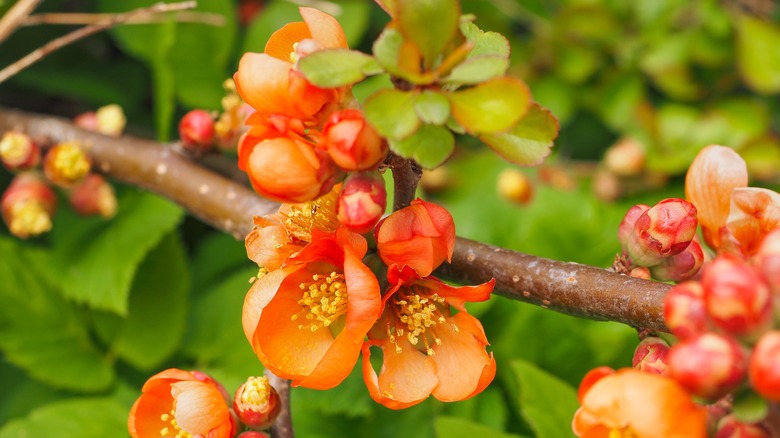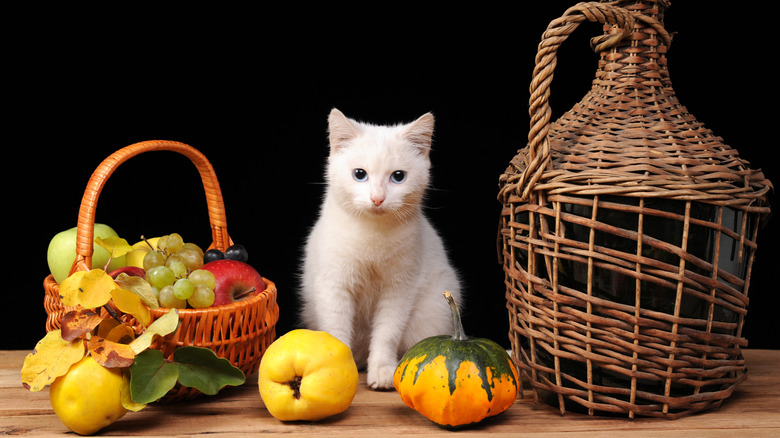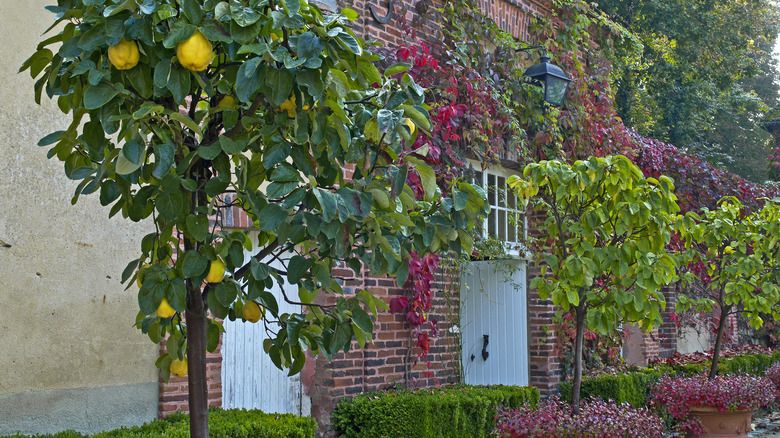Quince Tree: Everything You Should Know Before Planting
With sweetly scented pink or white spring blossoms set against bright green foliage, quince trees come in both flowering and fruiting varieties. Cydonia oblonga is the species that produces the delicious yellow fruit known for its similarities to apples and pears. Quince fruit trees are originally from western Asia and remain popular throughout the southern United States. However, because they so closely resemble pear trees, there has been quite a bit of confusion regarding their botanical classifications.
According to Integrated Pest Management at the University of Missouri, in the late 1700s, they were named Pyrus japonica by botanist Carl P. Thunberg. About 20 years later, Christiaan H. Persoon moved them out of the Pyrus genus and into the Cydonia classification. But it wasn't until 1822 that John Lindley properly distinguished them from their flowering cousins. Per Tucson.com, the somewhat rare fruit first made an appearance in Arizona as far back as the 1600s when Jesuit and Franciscan missionaries planted orchards throughout the Sonoran Desert.
To this day, local nurseries continue to grow new trees from cuttings of the original heirloom varieties. Quince trees are sturdy, while their flowers are absolutely delightful. The only drawback of this lovely tree seems to be that fruit itself is too bitter to eat straight from the branch as an apple or pear would be. But as they are cooked down, they sweeten up just enough to make them a popular addition to homemade dishes.
How to use quince trees in a garden
According to The Davey Tree Expert Company, the best time of year to transplant a quince fruit tree into the ground is early spring while they remain dormant. However, it's important to get this done before they show any bud growth. Southern Living explains that it will be as long as five years before your tree bears any quince fruit and double that until it is produced steadily.
So, if you're planning to grow them in your garden in order to use them in your cooking, you'll need to sit back and get comfy because it's going to take a while. In the meantime, your quince tree will dazzle with blossom-covered branches throughout the spring and, come summertime, will offer substantial shade on those hot, sticky days. Topping out at around 15 or 20 feet tall, and just as wide, quinces make great stand-alone trees in the yard.
If your tree is planted in a tight space or an actual garden, be sure to consider the amount of shade the leafed-out branches will inevitably throw on anything that tries to grow beneath it. Otherwise, if you have extensive space, you might want to have a quince tree as part of a larger orchard with pears, apples, and other fruit trees. Cooked offers a delicious-sounding recipe for Scandinavian quince-plum jam, so perhaps that's the fruit tree combo you never knew you needed to have.
How to grow quince trees
Just as quince trees take a considerable amount of time to produce fruit, their cuttings take longer to root than most plants. Due to this lengthy process, Gardening Know How has some helpful tips to keep them alive and growing most healthily. First, it's important to time your cuts very early in the year; you must take them while the plant remains dormant. Out in the orchard, you're looking for new growth that has hardened into wood, so nothing that is still green and fleshy but also nothing that is too old. With a sharp, sterile knife or cutting shears, remove a piece of hardwood up to 1 foot long, making sure it contains growth nodes.
This method calls for rooting hormone and horticultural sand, both of which should be available online or at your local nursery. Horticultural sand is a growing medium made up of different kinds of sand. It does not contain soil, so it may seem a little strange to work with. However, Gardening Know How confirms that it's the best option for preventing root rot. Plant your cutting in the sand a few inches down and move it to a bright spot where it will stay for the next few months. You may be accustomed to covering seedlings with plastic bags to increase humidity. In the case of quince tree cuttings, you can still do that, but balance it out by giving them time to air out.
How to care for quince trees
Pruning, fertilizing, and keeping an eye out for diseases will be your main topics of concern regarding quince tree care. But, per Chris Bowers & Sons, pruning is best-taken care of late in the summer with a focus on cutting back upright branches and altogether removing anything growing in the wrong direction. For tall-growing orchard trees planted in the ground, you want to aim for keeping the first 4 feet of the trunk clear of any branches. Other than that, prune for two reasons; first, so that the interior branches receive access to air circulation and sunlight, and second, for shape.
Stark Bro's says to fertilize quince trees only twice per year; once in early spring and once mid-summer. Then, steering a few inches clear of the trunk, spread fertilizer rich in essential elements such as iron, zinc, magnesium, and copper over all the ground covered by the tree's canopy. For the most part, these trees are pest-resistant, but they are prone to rust and leaf blight. If you see orange spots or brown speckles on leaves, consult your nearest garden center for advice on how best to control these debilitating diseases. Integrated Pest Management adds that nitrogen will help protect them from fire blight.
Quince tree varieties
There are three fruiting quince tree variations known for boasting a quince that tastes more like a pineapple. They may just contain enough sweetness to make let you eat them straight from the tree: Cydonia oblonga 'Aromatnaya', or Russian quince, comes from the Black Sea region, Raintree Nursery notes. The fruit of the Crimea quince gives off a strong citrus scent and is hardy to USDA zone 4, per Planting Justice, while Pineapple quince with white-colored flesh is popular for bearing the most fruit.
- A unique quince tree option is the Cydonia oblonga 'Portugal,' which has a greener skin than most of the yellow varieties, and its flesh is pink. Raintree Nursery suggests stewing them with apples for a crimson sauce that will surprise your guests.
- As the common name suggests, Cooke's jumbo (Cydonia oblonga 'Cooke') produces the largest fruit, growing up to a diameter of 8 inches (via Specialty Produce).
When it comes to non-fruiting flowering quinces, there are several gorgeous varieties to choose from. The following is the most popular.
- Chaenomeles speciosa is shown above for its simply stunning red blossoms that usher in spring like a siren, Planting Tree notes.
Are quince trees toxic?
You may have heard that the seeds of apples and pears contain cyanide and are therefore considered poisonous, especially for pets like cats and dogs. So it would be no wonder if you were, in turn, concerned about quince fruit. Fortunately, you have nothing to worry about here, as all parts of a quince tree are considered safe and nontoxic, including stems, leaves, fruit, and seeds.
On the contrary, people use the flesh of the fruit and its seeds in traditional medicine in many different ways. For example, GreekMedicine.net explains that the fruit is astringent, meaning it tightens skin cells and bodily tissues. This quality aids in digestion and counterbalances diarrhea and hemorrhoids. eMedicineHealth adds that this astringency makes the fruit a good option for use as a wound dressing. Furthermore, the seeds are often used to cure cough and other lung and respiratory system issues.
Quinces are also safe to eat, but most agree they're too bitter to be consumed raw. However, once they've been cooked, they become sweet. They also have a high pectin content, making them perfect for jams and jellies; in fact, the English word marmalade comes from the Portuguese marmelada, which is traditionally made from quince, Atlas Obscura notes. They can also be used as a substitute for apples or pears in any recipe or form.
How to repot a quince tree
Sibley's Patio Quince is a dwarf option perfect for container garden growing because it will stay small at around 3 feet in height and width, as noted by Terrace. Through their step-by-step repotting guide on YouTube, Project Diaries shares the importance of taking great care of the fragile root systems of your fruit tree. If you're potting a dormant store-bought tree for the first time, soak the roots in water for a few hours before planting it in its container. Drainage holes and either broken pieces of terracotta or small rocks on the bottom of the container will expedite proper drainage. Perlite helps as well.
Add a significant amount of compost to your potting soil, up to 50%, and wet the mixture before planting as an extra measure to keep your tree from experiencing transplant shock. First, cover your rocks and terracotta pieces with a thin layer of soil. When moving the plant to its new pot, Project Diaries suggests looking for the soil line — the highest spot on the trunk that was originally buried in the soil. Use that same spot to gauge how much soil you need to pack into your pot and how deep to plant the tree. All that's left to do is add water.
Quinces: forbidden fruits and the Trojan war
Apparently, the quince tree has a long and sordid history. Although the fruiting quince originally hails from the western Asian regions of the Black Sea and the Caucasus Mountain Range, it didn't take long to spread their seeds west towards the Mediterranean. Fruit expert David Karp said in an interview for The Splendid Table that the quince might just be the actual forbidden fruit referred to in the Bible's story of the Garden of Eden. But is it possible that the quince actually started the Trojan war? He seems to think that maybe it did, and Magzter agrees.
Per the Greek legend regarding Helen of Troy, when Eris, the Goddess of Discord, was excluded from a wedding banquet, she got vengeance by etching the phrase "For the Most Beautiful One" on a ripe piece of hard-fleshed quince fruit and tossing it into the hall. The prince of Troy, Paris, was then forced to decide between Athena, Aphrodite, and Hera upon whom the honor should be bestowed. Following his choice of Aphrodite, a fight was said to break out, which led to the start of one of the most famous wars in history.
